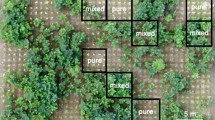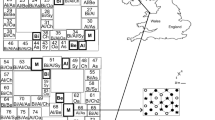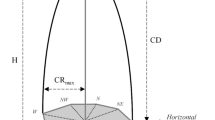Abstract
Wild pear (Pyrus pyraster (L.) Burgsd.) (P) and wild service tree (Sorbus torminalis (L.) Crantz) (S) are sporadic European tree species that are valued for their high-quality timber production. Although mixed plantations including companion species enhance timber quality of several trees, the performance of the association of P and S is not well known. The objective of this study was to assess growth and survival of P and S in pure plantations and in plantations mixed with other companion tree or shrub species in a non-native habitat. To answer the question of whether growth of these species is enhanced by mixtures, specific combinations of the main and companion species were established in central Chile and monitored for a 12-year period after planting. Besides each main species monoculture, five mixtures were tested: Mix1: P+S; Mix2: P+S+ the N-fixing tree Italian alder (Alnus cordata (Loisel.) Duby); and three associations of P and S including shrubs (Mix3: P+S+ Corylus avellana L., Mix4: P+S+ Sambucus ebulus L., and Mix5: P+S+ Sambucus nigra L.). Both P and S presented the highest height growth in Mix2, being 48.6% and 53.4% higher than in the monoculture, respectively. DBH growth was also enhanced in Mix2 for S. Wild service tree, which showed lower growth and survival than P, was more benefited from the mixture including Italian alder than P. Height growth, vigor and survival of the main species were highest in Mix2, even higher than in pure plantations and in Mix1 without companion species. Specific tree associations might increase the probability to obtain high-quality timber of noble species if a timely and adequate management of companion species is provided.



Similar content being viewed by others
References
Atkinson M, Atkinson E (2002) Biological flora of the British Isles. Sambucus nigra L. J Ecol 90:895–923
Aussenac R, Bergeron Y, Ghotsa Mekontchou C, Gravel D, Pilch K, Drobyshev I (2017) Intraspecific variability in growth response to environmental fluctuations modulates the stabilizing effect of species diversity on forest growth. J Ecol 105(4):1010–1020. https://doi.org/10.1111/1365-2745.12728
Battipaglia G, Pelleri F, Lombardi F, Altieri S, Vitone A, Conte E, Tognetti R (2017) Effects of associating Quercus robur L. and Alnus cordata Loisel on plantation productivity and water use efficiency. For Ecol Manag 391:106–114
Bauhus J, Forrester DI, Gardiner B, Jactel H, Vallejo R, Pretzsch H (2017) Ecological stability of mixed-species forests BT. In: Pretzsch H, Forrester DI, Bauhus J (eds) Mixed-species forests. Springer, Berlin, pp 337–382. https://doi.org/10.1007/978-3-662-54553-9_7
Bednorz L, Nowinska R (2018) Analysis of growth of recruits of natural regeneration of Sorbus torminalis (L.) Crantz, a rare European forest tree species. iForest 11(1):72–78. https://doi.org/10.3832/ifor2347-010
Bednorz L, Kazmierczak K, Kaczmarek L (2012) Analyses of spatial structure and selected measures of growth of Sorbus torminalis in Forest District Jamy (northern Poland). Dendrobiology 67:59–65
Bellini E, Giordani E, Giannelli G, Picardi E (2002) Le specie legnose da frutto, liste dei caratteri descrittivi. Arsia Ed., Florence, Italy
Burde E (ed) (1989) Walnut notes. United States Department of Agriculture. Forest Service, North Central Forest Experiment Station, New York
Buresti Lattes E (1995) Walnut trees in mixed stands with shrubs and trees. In European development of Walnut and fruit production as an alternative and extensive system to agricultural crops. Thessaloniki, Greece: Workshop of E.U. Air/Walnut Project, March 27–30, pp 72–81
Buresti Lattes E, Mori P (2016) Progettazione, Realizzazione e Gestione delle Piantagioni da legno Policicliche di tipo Naturalistico (Compagnia). InBioWood. Retrieved from https://books.google.cl/books?id=SznODQAAQBAJ
Burke A, Kageyama M, Latombe G, Fasel M, Vrac M, Ramstein G, James PMA (2017) Risky business: the impact of climate and climate variability on human population dynamics in Western Europe during the last glacial maximum. Quat Sci Rev 164:217–229. https://doi.org/10.1016/J.QUASCIREV.2017.04.001
Cedro A (2013) Dendrochronological analysis of Quercus pubescens and Pyrus pyraster from the Bielinek Reserve (NW Poland). Plant Divers Evolut 130(3):195–202. https://doi.org/10.1127/1869-6155/2013/0130-0065
Cedro A (2016) The influence of climatic conditions on the tree-ring width of wild service trees (Sorbus torminalis L.) in Wielkopolska. For Res Pap 77(2):117–123
Cedro A, Wojciech A (2016) Dendroclimatological analysis of Wild Pear Pyrus pyraster (L.) Burgsd. from Biedrusko Military Area (West Poland), preliminary Study. Geochronometria 43(1):18–23. https://doi.org/10.1515/geochr-2015-0029
Ching-Liu CL, Kuchma O, Krutovsky K (2018) Mixed-species versus monocultures in plantation forestry: development, benefits, ecosystem services and perspectives for the future. Glob Ecol Conserv 15:e00419
Crave MF (1985) Un frutier meconnu: l’alisier torminal. Fôret Entreprise 28:14–20
Cutini A, Giannini T (2009) Effects of thinning and mixed plantations with Alnus cordata on growth and efficiency of common walnut (Juglans regia L.). Forest, Rivista Selvicoltura ed Ecologia Forestale. https://doi.org/10.3832/efor0553-006
Di Rienzo JA, Casanoves F, Balzarini MG, Gonzalez L, Tablada M, Robledo CW (2019) InfoStat version 2019. Retrieved Jan 28, 2019, from http://www.infostat.com.ar
Forrester DI, Bauhus J, Cowie AL (2006) Mixed-species plantations of Eucalyptus with nitrogen-fixing trees: a review. For Ecol Manag 233(2–3):211–230. https://doi.org/10.1016/J.FORECO.2006.05.012
Frattegiani M (1996) Il ciavardello (Sorbus torminalis (L.) Crantz). Sherwood 17:19–22
Gabriel K, Blair I, Mason WL (2005) Growing broadleaves trees on the North York Moors, results after nearly 50 years. Q J For 99:21–30
Gonin P, Larrieu L, Coello J, Marty P, Lestrade M, Becquey J, Classens H (2013) Autoecología de las frondosas nobles. Institute pour le Développement Forestier, Paris
Grilli G, Jonkisz J, Ciolli M, Lesinski J (2016) Mixed forests and ecosystem services: investigating stakeholders’ perceptions in a case study in the Polish Carpathians. For Policy Econ 66:11–17. https://doi.org/10.1016/J.FORPOL.2016.02.003
Gurovich LA (1979) Características hídricas de los suelos y eficiencias de riego. IREN-CORFO Publ 25:22–29
Hemery GE (2001) Growing Walnut in mixed stands. Q J For 95(1):31–36
IPCC (2013) Climate change 2013: the physical science basis. Contribution of working group i to the fifth assessment report of the intergovernmental panel on climate change. In: Stocker T, Qin S, Plattner g, Tignor M, Allen S, Boschung J, Nauels A, Xia A, Bex V, Midgley P (eds). Cambridge University Press, Cambridge
Knoke T, Ammer C, Stimm B, Mosandl R (2008) Admixing broadleaved to coniferous tree species: a review on yield, ecological stability and economics. Eur J For Res 127(2):89–101. https://doi.org/10.1007/s10342-007-0186-2
Kuehne C, Kublin E, Pyttel P, Bauhus J (2013) Growth and form of Quercus robur and Fraxinus excelsior respond distinctly different to initial growing space: results from 24-year-old Nelder experiment. J For Res 24(1):1–14
Kunz J, Räder A, Bauhus J (2016) Effects of drought and rewetting on growth and gas exchange of minor European broadleaved tree species. Forests. https://doi.org/10.3390/f71100239
Kunz J, Löffler G, Bauhus J (2018) Minor European broadleaved tree species are more drought-tolerant than Fagus sylvatica but not more tolerant than Quercus petraea. For Ecol Manag 414:15–27. https://doi.org/10.1016/j.foreco.2018.02.016
Lakatos F, Mirtchev S (2014) Manual for visual assessment of forest crown condition. Food and Agriculture Organization of the United Nations, Pristina. Retrieved from http://www.fao.org/3/a-i4214e.pdf
Loewe MV, Siebert H, González Y, González OM (2008) Consociazione e caratteristiche stazionali. Sperimentazioni in impianti di raulí in Cile. Sherwood 140:48–49
Loewe MV, González OM, Balzarini M (2013) Wild cherry tree (Prunus avium L.) growth in pure and mixed plantations in South America. For Ecol Manag 306:31–41. https://doi.org/10.1016/J.FORECO.2013.06.015
Matthews JD (1987) The silviculture of alders in Great Britain. Natural Hardwoods Programme, Report of the Seventh Meeting, 8 January 1987, pp 29–38
Meier-Dinkel A (2006) Improving wild cherry (Prunus avium), wild pear tree (Pyrus pyraster) and wild service tree (Sorbus torminalis) by combining progeny testing and micropropagation. In IUFRO Division 2: joint conference “low input breeding and genetic conservation of forest tree species”. Antalya, Turkey, pp 143–143
Mohni C, Pelleri F, Hemery GE (2009) The modern silviculture of Juglans regia L.: a literature review. Die Bodenkultur 59:19–32
Monteiro MDL, Caldas S, Maria Do Sameiro P, Nunes LF, Pereira E (2009) Mixed forests plantations with naturalized broadleaves and nitrogen fixing species. In: XIII World forestry congress. Buenos Aires, Argentina. Retrieved from https://bibliotecadigital.ipb.pt/bitstream/10198/3603/1/Monteiroetal2009XIIIWFCresumo.pdf
Mori P, Pelleri F, Bianchetto E, Fantoni I, Magni A, Miozzo M, Sansone D (2014) Selvicoltura per le specie arboree sporadiche. Manuale tecnico per la selvicoltura d’albero proposta dal progetto LIFE + PProSpoT. Arezzo, Italy. Retrieved from https://www.ecoalleco.it/gratuiti/raft-rapporto-sullo-stato-delle-foreste-della-regione-toscana-2005-47.html
Neri D, Urbinati C, Savini G, Sanchioni A (2005) Age determination and tree-ring growth dynamic in old tree of Pyrus communis “Angelica”. In: Acta Horticulturae. International Society for Horticultural Science (ISHS), Leuven, Belgium, pp 623–629. https://doi.org/10.17660/ActaHortic.2005.671.87
Nicolescu VN, Hochbichler E, Coello GJ, Ravagni S, Giulietti V (2009) Ecology and silviculture of wild service tree (Sorbus torminalis (L.) Crantz): a literature review. Die Bodenkultur 60(3):35–44
O’Neill BC, Oppenheimer M, Warren R, Hallegatte S, Kopp RE, Pörtner HO, Scholes R, Birkmann J, Foden W, Licker R, Mach KJ, Marbaix P, Mastrandrea MD, Price J, Takahashi K, Van Ypersele J, Yohe G (2017) IPCC reasons for concern regarding climate change risks. Nat Clim Change 7:28–37. https://doi.org/10.1038/nclimate3179
Paganová V (2003) Wild pear Pyrus pyraster (L.). Burgsd requirements on environmental conditions. Ekologia Bratislava 22(3):225–241
Paganová V (2007) Ecology and distribution of Sorbus torminalis (L.) Crantz. in Slovakia. Hortic Sci 34(4):138–151
Paganová V (2008) Ecological requirements of wild service tree (Sorbus torminalis (L.) Crantz) and service tree (Sorbus domestica L.) in relation with their utilization in forestry and landscape. J For Sci 54(5):216–226
Paganová V, Jureková Z, Lichtnerová H (2019) The nature and way of root adaptation of juvenile woody plants Sorbus and Pyrus to drought. Environ Monit Assess. https://doi.org/10.1007/s10661-019-7878-1
Palacio-Bielsa A, López-Quílez A, Llorente I, Ruz L, López M, Cambra MA (2012) Criteria for efficient prevention of dissemination and successful eradication of Erwinia amylovora (the cause of fire blight) in Aragón, Spain. Phytopathologia Mediterranea 51(3):505–518
Pelleri F, Ravagni S, Bianchetto E, Bidini C (2013) Comparing growth rate in a mixed plantation (walnut, poplar and nurse trees) with different planting designs: results from an experimental plantation in northern Italy. Ann Silvicult Res 37(1):13–21. https://doi.org/10.12899/asr-750
Piagnani MC, Costa C, Minotta G, Bassi D (2018) Preliminary phenotypic characterization of Sorbus domestica and S. torminalis under selection for timber production. Agrofor Syst 92:589–597
Piotto D (2008) A meta-analysis comparing tree growth in monocultures and mixed plantations. For Ecol Manag 255(3–4):781–786. https://doi.org/10.1016/J.FORECO.2007.09.065
Piotto D, Vı́quez E, Montagnini F, Kanninen M (2004) Pure and mixed forest plantations with native species of the dry tropics of Costa Rica: a comparison of growth and productivity. For Ecol Manag 190(2–3):359–372. https://doi.org/10.1016/J.FORECO.2003.11.005
Pretzsch H, Schütze G (2016) Effect of tree species mixing on the size structure, density, and yield of forest stands. Eur J For Res 135(1):22. https://doi.org/10.1007/s10342-015-0913-z
Pyttel P, Kunz J, Bauhus J (2011) Age and growth of wild service tree (Sorbus torminalis (L.) Cranz) in former oak coppice forests in southwest Germany. Tree Rings Archeol Climatol Ecol 9:64–70
Pyttel P, Kunz J, Bauhus J (2013) Growth, regeneration and shade tolerance of the wild service tree (Sorbus torminalis (L.) Cranz) in aged oak coppice forests. Trees 27:1609–1619
Rasmussen KK (2007) Dendroecological analysis of a rare sub-canopy tree: effects of climate, latitude, habitat conditions and forest history. Dendrochronologia 25(1):3–17. https://doi.org/10.1016/J.DENDRO.2007.01.002
Saha S, Kuehne C, Bauhus J (2014) Intra- and interspecific competition differently influence growth and stem quality of young oaks (Quercus robur L. and Quercus petraea (Mattuschka) Liebl.). Ann For Sci 71:381–393
Schäfer C, Rötzer T, Thurm EA, Biber P, Kallenbach C, Pretzsch H (2019) Growth and tree water deficit of mixed Norway spruce and European beech at different heights in a tree and under heavy drought. Forests 10(7):577. https://doi.org/10.3390/f10070577
Stroup W (2012) Generalized linear mixed models: modern concepts, methods and applications. CRC Press, Boca Raton
Tabari M (2008) Survival, growth and vitality effects of man-made Fagus orientalis seedlings after cleaning Sambucus ebulus in a Caspian Forest Site. Int J Bot 4(3):331–335
Tani A, Maltoni A, Mariotti B, Buresti Lattes E (2006) Gli impianti da legno di Juglans regia realizzati nell’area mineraria di S. Barbara (AR). Valutazione dell’effetto di piante azotofissatrici accessorie. Forest@ 3(4):588–597
Thomas PA (2017) Biological flora of the British Isles: sorbus torminalis. J Ecol 105:1806–1831. https://doi.org/10.1111/1365-2745.12857
Varela S, Caballé G, Diez J, Godoy M, Willems P (2017) Evaluation of plantation and early development of five alternatives to ponderosa pine in silvopastoral systems in northwest Patagonia, Argentina. Agrofor Syst 91(5):981–991. https://doi.org/10.1007/s10457-016-9972-5
Vilà M, Vayreda J, Comas L, Ibáñez JJ, Mata T, Obón B (2007) Species richness and wood production: a positive association in Mediterranean forests. Ecol Lett 10(3):241–250. https://doi.org/10.1111/j.1461-0248.2007.01016.x
Walentowski H, Falk W, Mette T, Kunz J, Bräuning A, Meinardus C, Leuschner C (2017) Assessing future suitability of tree species under climate change by multiple methods: a case study in southern Germany. Ann For Res 60(1):101–126. https://doi.org/10.15287/afr.2016.789
West B, Welch K, Galecki A (2014) Linear mixed models: a practical guide using statistical software, 2nd edn. CRC Press, New York
Zuppinger-Dingley D, Schmid B, Petermann JS, Yadav V, De Deyn GB, Flynn DFB (2014) Selection for niche differentiation in plant communities’ increases biodiversity effects. Nature 515:108–111. https://doi.org/10.1038/nature13869
Acknowledgements
The authors thank Frutifor Ltd. for its active collaboration in trial establishment and tending during 12 years, and the Chilean Ministry of Agriculture for funding measurements and analyses.
Funding
This work was supported by the Chilean Ministry of Agriculture and trial establishment and management were supported by the Foundation for the Agriculture Innovation (FIA), Ministry of Agriculture, Chile, project “Mixed plantations: productivity, diversity and sustainability for the forest development” (Grant Number C00-1-F-028).
Author information
Authors and Affiliations
Corresponding author
Ethics declarations
Conflict of interest
The authors declare that they have no conflict of interest.
Additional information
Communicated by Christian Ammer.
Publisher's Note
Springer Nature remains neutral with regard to jurisdictional claims in published maps and institutional affiliations.
Electronic supplementary material
Below is the link to the electronic supplementary material.
Rights and permissions
About this article
Cite this article
Loewe-Muñoz, V., Del Río, R., Delard, C. et al. Mixed Pyrus pyraster and Sorbus torminalis plantations including companion species enhance high-quality timber production. Eur J Forest Res 139, 655–664 (2020). https://doi.org/10.1007/s10342-020-01278-4
Received:
Revised:
Accepted:
Published:
Issue Date:
DOI: https://doi.org/10.1007/s10342-020-01278-4




